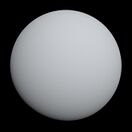Astronomy:Kepler-395c
From HandWiki
Short description: Potential goldilocks Super-Earth orbiting Kepler-395
| Discovery | |
|---|---|
| Discovered by | Jason F. Rowe et al.[1] |
| Discovery site | Kepler |
| Discovery date | February 26, 2014 |
| Transit method | |
| Orbital characteristics | |
| Orbital period | 34.989262[1] d |
| astron|astron|helion}} | JD 2454977.22265[1] |
| Star | Kepler-395 |
| Physical characteristics | |
| Mean radius | 1.32[1] R⊕ |
| Mean density | 2.7856 g/cm3 (0.10064 lb/cu in)[1] |
Kepler-395c is a potentially habitable[citation needed] exoplanet 616 light-years away in the constellation of Cygnus.[2]
Habitability and Properties
It orbits an M-type star. It's radius is 1.32 ± 0.09 times that of Earth.[1] It orbits at 0.177 AU[3] with an orbital period of 34.9893 days.[1] Because of its proximity to its star, it's likely to be tidally locked, meaning one side always facing the star, and one side always facing away. This means one side is blistering hot, and one side is bitter cold. However, in between those hostile zones, there would be a sliver of habitability. If it has a thick enough atmosphere, the sliver may even be global.[citation needed]
See also
References
- ↑ Jump up to: 1.0 1.1 1.2 1.3 1.4 1.5 1.6 Rowe, Jason F. et al. (2014). "Validation of Kepler's Multiple Planet Candidates. III. Light Curve Analysis and Announcement of Hundreds of New Multi-planet Systems". The Astrophysical Journal 784 (1): 20. doi:10.1088/0004-637X/784/1/45. 45. Bibcode: 2014ApJ...784...45R.
- ↑ Muirhead, Philip S; Becker, Juliette; Feiden, Gregory A; Rojas-Ayala, Bárbara; Vanderburg, Andrew; Price, Ellen M; Thorp, Rachel; Law, Nicholas M et al. (2014). "Characterizing the Cool KOIs. VI. H- and K-band Spectra of Kepler M Dwarf Planet-Candidate Hosts". The Astrophysical Journal Supplement Series 213 (1): 5. doi:10.1088/0067-0049/213/1/5. Bibcode: 2014ApJS..213....5M.
- ↑ "Kepler-395 c". https://exoplanets.nasa.gov/exoplanet-catalog/4818/kepler-395-c/.
 |




